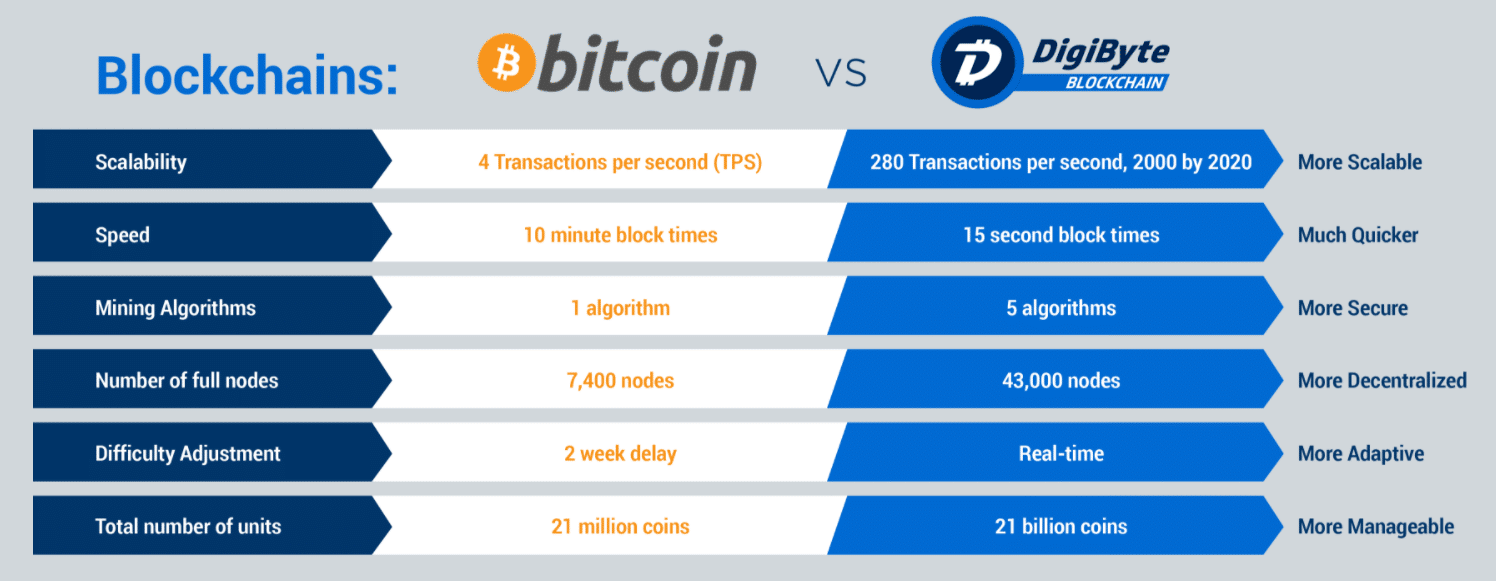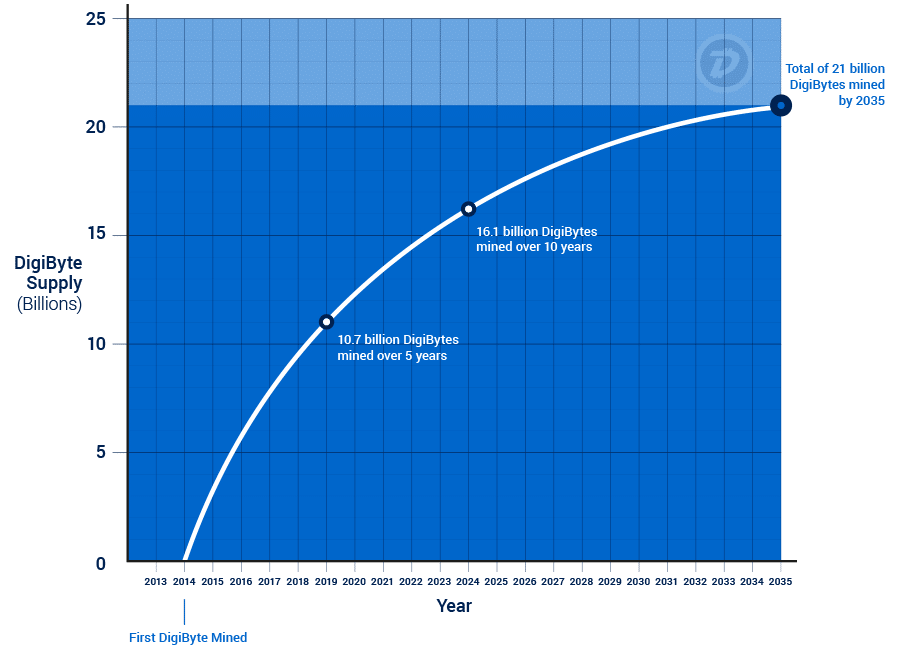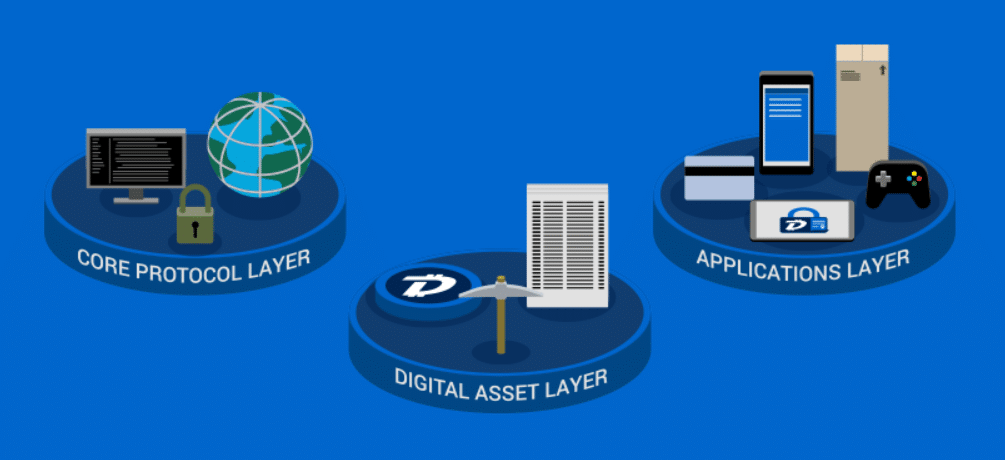What is DigiByte?
DigiByte is a cryptocurrency that focuses on security, decentralization, and speed. Founded in 2014, it’s part of the older class of cryptocurrency projects. However, despite its age and ongoing development over the past four years, DigiByte is still relatively unknown.
DigiByte’s supporters argue that it’s the sleeping giant of cryptocurrency. According to its fans, it’s on the cutting edge of crypto-technology. It hosts a network that’s faster, more scalable, and more secure than other major currencies. Over time, they argue, its superior technology will win out against Bitcoin, Litecoin, and other top digital cash options. DigiByte has a dedicated community and nearly 100,000 nodes across the globe.
On the other hand, DigiByte’s adoption over the past four years has been slow. It’s still a relatively obscure currency compared its competitors. The DigiByte website offers a lot of great marketing copy and buzzwords. However, there’s little technical information about how the network actually functions. It’s difficult to get a sense of the real achievements of DigiByte versus things they have planned for the future.
In this article, we’ll try to dig deeper into the DigiByte platform – its history, technological specifications, and its achievements. In the end, you’ll have to make your own decisions about whether DigiByte is the next big thing or mostly fluff.
Digibyte History & Team
Jared Tate developed DigiByte in 2013 and launched the genesis block in January 2014. At the time, DigiByte was one of only a handful of public blockchain projects. It launched without an initial token sale and with little fanfare.

After the launch, Tate dedicated himself full time to DigiByte’s development. Since then, funding for the project has come through donations to the DigiByte foundation. It’s also reasonable to assume that Tate and others involved in the project hold a significant amount of DGB (the DigiByte coin) from mining and initial transactions. Their wealth would increase any time the price of DGB increases.
Speaking of other people working on the DigiByte team, it’s difficult to find much out about the staff supporting the project. The website doesn’t contain information about the team. A little digging on LinkedIn turned up a total of five developers who claim to work for DigiByte, including Tate.
Without team members dedicated to marketing, project management, and community outreach, it’s difficult to see how Digibyte’s adoption will grow in the now-crowded crypto space. Over the past year, Tate has said he’s working on setting up the Foundation and public-facing marketing for DigiByte’s growth phase.
Spikes & Crashes in Price
As with all cryptocurrency, DigiByte’s price has been volatile recently. Up until 2017, it’s price remained relatively constant, with only slight growth. However, 2017 and 2018 saw a series of spikes and crashes for DGB.
A June 2017 spike came when DigiByte hinted at an impending announcement on Twitter. Investors looking to make money off the announcement quickly bought into DigiByte. This pumped the price. However, the announcement didn’t come for several more days. It introduced a new wallet and a few added features. By the time of the announcement, the price of DGB had already collapsed to near pre-announcement levels.
Digibyte’s price spiked again in December 2017-January 2018. John McAfee, a popular crypto-investor, tweeted about DigiByte as a company worth watching. The resulting December spike carried into the new year. But, it eventually collapsed along with the rest of the crypto market in the correction of January 2018.

Technical Specs
Like Bitcoin, DigiByte is a UTXO-based cryptocurrency. This means that new transactions don’t come from a wallet “balance.” Instead, each individual coin has an identifier. When a coin enters your wallet, it is considered “unspent” by your wallet. When you send that coin to someone else, it becomes a spent coin. This prevents the double spend problem of digital currency. It also solves other security issues with the blockchain.
Blocks, Mining, and Hashing Algos
DigiByte launched its genesis block on January 10th, 2014. At launch, it used a single proof of work algorithm. Soon after, however, DigiByte conducted a hard fork to introduce a total of five proof of work algorithms. Splitting the mining between algorithms encourages decentralization and increases the security of the network.
A new DigiByte block is mined approximately every 15-18 seconds. Each of the five mining algorithms mines one block every 1.5 minutes. Within each block, transaction sizes are limited. DigiByte was also the first to implement Segregated Witness technology, helping keep its blockchain small and scalable. The fast blocktime combined with four years of existence means DigiByte has the longest blockchain currently in existence. Longer even than Bitcoin’s.
Coin Supply & Buying DGB

Ultimately, the DigiByte blockchain will mine 21 billion DGB over the course of 21 years. There are currently 8.1 billion DGB in circulation. You can purchase DGB on most major exchanges or join a mining pool to mine it. DigiByte’s various algorithms support ASIC and GPU mining.
Layered Infrastructure

The DigiByte software infrastructure consists of three layers that function on top of one another:
- Core Communications & Global Network – This connects all the nodes on the network together. It supports very basic data transfer between nodes and establishes the foundation for other layers.
- Public Ledger & Digital Assets – This is where the network’s data gets stored. It also has security measures in place to prevent manipulation of data. It incentivizes and manages miners securing the platform.
- Applications – This is the user-facing part of the blockchain. It involves the interface, transfers, API, and any other everyday applications built on the DigiByte network.
Faster Block Time & Higher Throughput
DigiByte’s faster block time means transactions get processed and confirmed much faster on its network. DigiByte’s block time is 15 seconds, placing it around 40x faster than Bitcoin. Of course, faster block time comes with scalability issues as each node on the network must maintain the entire history of the blockchain in order to confirm new transactions. DigiByte’s blockchain is already the longest in the world.
To counter these challenges, DigiByte was the first cryptocurrency to implement segregated witness. SegWit separates transaction confirmations from the transaction information in the block. This makes the ledger more compact. In addition, SegWit allows for innovations like cross-chain transactions and single confirmation transactions. These options are potential avenues for development on DigiByte’s blockchain.
DigiByte also limits transaction size and scope. There’s little documentation explaining how this works exactly, but DigiByte claims such limitations on transactions make their blockchain more efficient. In addition, limiting transaction scope theoretically protects the security of the network.
Fast block times and small transaction size allow DigiByte to have a throughput of around 280 transactions per second. That’s fast compared with Bitcoin’s current eight transactions per second. However, it pales in comparison to payment processors like Visa, who can handle 2,000 transactions per second. DigiByte plans to reach the 2,000 transactions per second mark set by Visa and possibly surpass it. So far, however, those plans are still vague, without a clear roadmap.
More Secure
DigiByte also claims to be more secure than other currencies. Putting security first to DigiByte means making sure the entire platform is as decentralized as possible. This is part of the reason why DigiByte’s team hasn’t grown significantly. They’ve left much of the promotion and development of DigiByte up to the community, in true decentralized fashion. The problem, of course, is one of coordination. While many people have contributed to the DigiByte code base and proselytized the platform, it has largely been ad hoc, without much clear direction from the DigiByte Foundation.
DigiByte has, however, been successful at decentralizing its mining. They’ve done so largely through good mining incentives and use of five algorithms. These mining algorithms split miners and mining power into five equal, smaller groups. This keeps mining competitive while still allowing for each group to mine a block every 1.5 minutes. The DigiByte blockchain has over 100,000 nodes across six continents.
DigiByte rebalances the load between the five mining algorithms by adjusting the difficulty of each so one algorithm doesn’t become dominant. This rebalancing technology is called MultiShield, and it’s one of DigiByte’s technical advancements. MultiShield’s early prototype, DigiShield, implemented responsive difficulty adjustment to prevent miners with lots of processing power from manipulating smaller blockchains. DigiShield’s asymmetric difficulty has gained notoriety and been deployed in many other blockchains.
Development Ahead of the Curve
DigiByte has established a reputation for being on the cutting edge of crypto-development. Its DigiShield technology gained wide acceptance as a solution for difficulty adjustment. It was also the first blockchain to implement SegWit. MultiAlgo mining has yet to catch on. However, that’s another area DigiByte has pioneered in the blockchain industry.
Since DigiByte has the longest blockchain in existence, they’ve also faced scalability issues that other chains have yet to encounter. DigiByte’s blockchain is over 5 million blocks long. However, being on the cutting edge of development also leaves room for error. Until user adoption grows to the levels of the top cryptocurrencies, it’s difficult to say if DigiByte’s technology is robust as it claims.
In the future, DigiByte has plans to support smart contracts development on top of its blockchain. The developer community needs reliable, open-source tools to implement DigiByte apps and services. DigiByte.JS will provide a reliable API for JavaScript apps that need to interface with the platform.
DigiByte’s website also claims the platform will support AI and IoT applications built on its blockchain.
Future of Digibyte
Traction is the name of the game for DigiByte. So far in its four-year history, it hasn’t gotten much. 100,000 nodes is a respectable network size for an alternative currency. However, DigiByte is a relatively old currency, and it has had opportunities to gain massive support with the right messaging and public relations.
DigiByte is currently gaining traction in gaming community. An offshoot of DigiByte, DigiByte Gaming, offers DGB to gamers in exchange for time spent playing certain games.
Tate, the CEO, has promised to focus on public outreach and the DigiByte Foundation this year. At this point, gaining greater adoption is the largest challenge facing the project. DigiByte’s fate hangs in the balance. It could take off as a leader in speed, scalability, and security; or it could languish in continued relative obscurity.
The post What is DigiByte? Sleeping Giant or Unknown Quantity? appeared first on CoinCentral.

TheBitcoinNews.com – Bitcoin News source since June 2011 –
Virtual currency is not legal tender, is not backed by the government, and accounts and value balances are not subject to consumer protections. TheBitcoinNews.com holds several Cryptocurrencies, and this information does NOT constitute investment advice or an offer to invest.
Everything on this website can be seen as Advertisment and most comes from Press Releases, TheBitcoinNews.com is is not responsible for any of the content of or from external sites and feeds. Sponsored posts are always flagged as this, guest posts, guest articles and PRs are most time but NOT always flagged as this. Expert opinions and Price predictions are not supported by us and comes up from 3th part websites.
Advertise with us : Advertise
Our Social Networks: Facebook Instagram Pinterest Reddit Telegram Twitter Youtube










